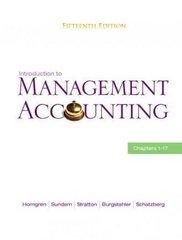Question
Hello tutor Help me with managerial accounting. 1.Which of the accompanying attributes doesn't relate to the board bookkeeping? a. provides data and assessments about future
Hello tutor Help me with managerial accounting.
1.Which of the accompanying attributes doesn't relate to the board bookkeeping?
a. provides data and assessments about future movement
b. generates explicit reason budget summaries and reports
c. provides monetary and working information multidisciplinary in extension
d. has remotely forced principles
2.Which of the accompanying doesn't depict the board bookkeeping?
a. evaluation of portions or items inside the firm
b. emphasis on what's to come
c. externally engaged
d. detailed data
3. Management bookkeeping reports are readied
a. to address the issues of leaders inside the firm.
b. whenever investors demand them.
c. according to rules arranged by the offers and Financial Services Authority.
d. according to monetary bookkeeping norms.
4. Cost bookkeeping
a. is worried about allotting expenses to different expense objects.
b. attempts to fulfill the costing destinations of both monetary bookkeeping and the executives bookkeeping.
c. provides cost data that supports arranging, controlling, and dynamic.
d. All of the above depictions are valid.
5. Which of the accompanying costing exercises is related with the monetary bookkeeping framework?
a. determining the expense of an office
b. determining the expense of merchandise sold for fiscal summaries
c. preparing spending plans
d. determining the expense of a client
6. Which of the accompanying exercises isn't related with the monetary bookkeeping data framework?
a. reporting on the expense of value
b. reporting to the investors
c. preparing reports for the assessment specialists
d. preparing an assertion of incomes
7. Which of the accompanying expense the board instruments bolsters the company's focus on the conveyance of significant worth to the client?
a. service industry development
b. global rivalry
c. preparing an income report for outside announcing
d. value-chain examination
(try not to offer wrong answers, otherwise I'll downvote, select right responses as it were)
{A}
This organization holds $100,000 in records receivable yet just hopes to gather $93,000
in view of the accessible proof. The $7,000 decrease in the resource is a cost. When should the
cost be perceived? These deals were made in Year One yet the character of the particular clients who
neglect to pay and the specific adds up to be eliminated won't be resolved until Year Two. Should terrible obligation
cost be perceived in the exact year as the deals by depending on a gauge or postponed until the genuine
results are in the end concluded?
{B} When budget summaries are readied, a cost should be perceived and the receivable
balance decreased to net feasible worth. Notwithstanding, in the above changing section, for what reason was the records
receivable record not straightforwardly diminished by $7,000 to the foreseen total of $93,000? This
approach is more straightforward just as more clear. For what reason was the $7,000 added to a stipend
account? In revealing receivables, why go to the difficulty of setting up a different recompense?
{C} The organization in this delineation hopes to gather a sum from its receivables that won't
substantially vary from $93,000. The related $7,000 cost is recorded in a similar period as the
income through a changing passage. What happens when a real record is resolved to be
uncollectible? For instance, expect that on March 13, Year Two, a $1,000 surplus ends up being
useless. The client kicks the bucket, opts for non-payment, vanishes, or simply won't make installment. This is
not another cost; $7,000 was at that point envisioned and perceived in Year One. It is only the first
revelation. How does the resulting discount of a receivable as being uncollectible influence the different T account adjusts?
{D} After a record receivable has been discounted as uncollectible, does the organization stop in its
endeavors to gather the sum due from that client?
{E} toward the finish of Year One, the organization assessed that $7,000 of its records
receivable will at last end
up being uncollectible. Notwithstanding, in Year Two, that figure is probably going to be
refuted. The real sum likely could be $6,000 or $8,000 or numerous different numbers. At the point when the
exact figure is known, does an organization get back to its Year One fiscal reports and change them to
this right equilibrium? Should an organization keep revealing an expected figure whenever it has been appeared
to be wrong?
Step by Step Solution
There are 3 Steps involved in it
Step: 1

Get Instant Access to Expert-Tailored Solutions
See step-by-step solutions with expert insights and AI powered tools for academic success
Step: 2

Step: 3

Ace Your Homework with AI
Get the answers you need in no time with our AI-driven, step-by-step assistance
Get Started


